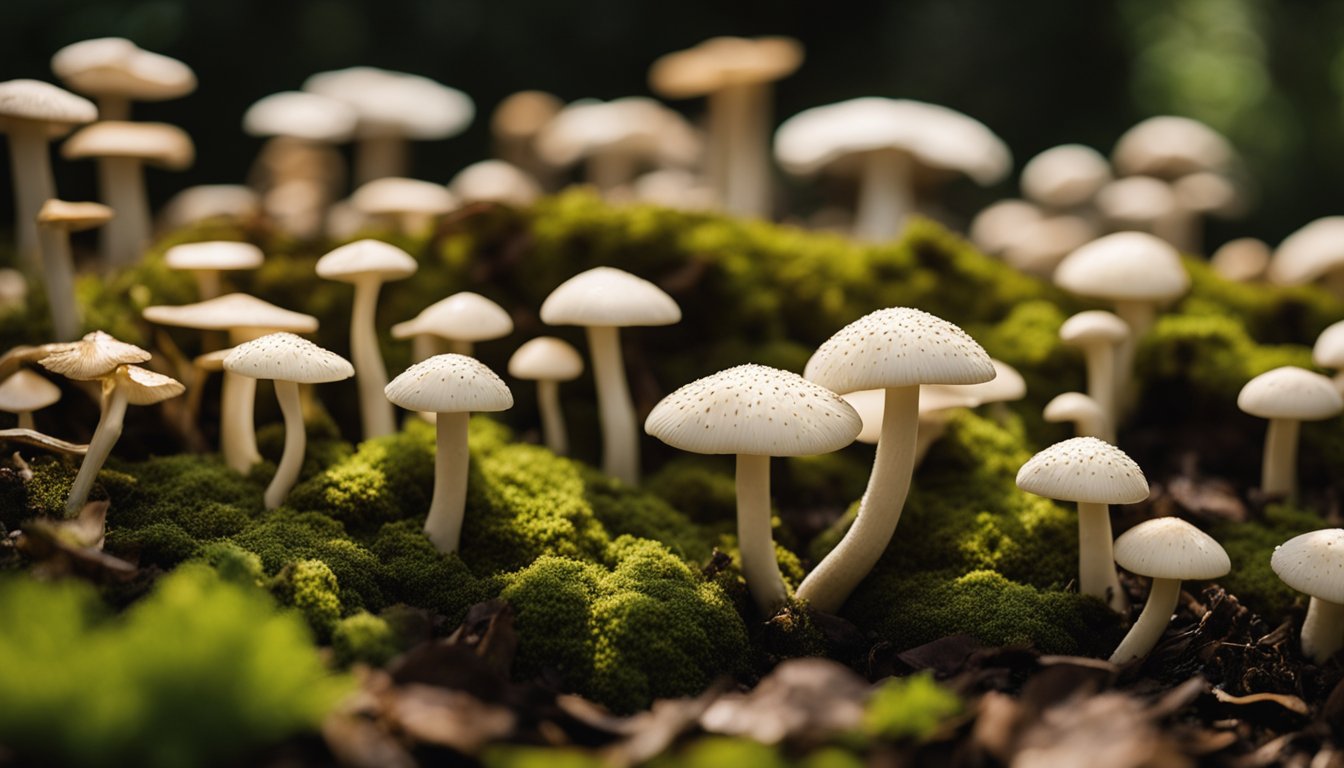If you’ve ever savored the delicate flavor of shimeji mushrooms, you know just how special they are. These little gems not only elevate dishes with their unique taste but also pack a nutritional punch. Imagine the satisfaction of growing your own shimeji mushrooms right at home. It’s easier than you might think and can be a rewarding venture for any food lover or aspiring gardener.
Cultivating shimeji mushrooms opens up a world of culinary possibilities while also providing a fun and engaging hobby. Whether you’re a seasoned grower or a curious beginner, I’ll guide you through the simple steps to get started. With the right techniques and a bit of patience, you’ll be harvesting your own fresh mushrooms in no time. Let’s dive into the fascinating world of shimeji mushroom cultivation and discover how you can bring this delicious delicacy to your kitchen.
Overview Of Shimeji Mushroom Cultivation
Shimeji mushrooms thrive in controlled environments. I find their growth process fascinating. These mushrooms prefer wood-based substrates. Hardwood sawdust or wood chips work wonders for their cultivation.
Temperature plays a key role in shimeji mushroom growth. I keep the environment at around 60 to 70°F (15 to 21°C). This range keeps them happy. Humidity is equally important. Maintaining 85% to 95% humidity creates an ideal setting.
To start, I prepare the substrate. I sterilize it to eliminate unwanted microbes. This step ensures the success of the shimeji mushrooms. After sterilization, I introduce the mushroom spawn. I mix it thoroughly with the substrate for uniform distribution.
Next, I place the mixture in containers. I use bags or jars with breathable lids. These containers allow fresh air while preventing contamination. Within a few weeks, the mycelium spreads throughout the substrate. It looks like fluffy white strands.
I check the moisture levels regularly. If the substrate dries out, the mushrooms will not grow. I mist the substrate lightly to maintain the humidity. It’s a simple yet effective technique.
Once the mycelium grows fully, I initiate fruiting. I lower the temperature a bit and expose the substrate to light. This change signals the mushrooms to grow. With proper care, I see shimeji mushrooms sprouting within days.
Harvesting them is the best part. I gently twist and pull to avoid damaging the mycelium. Freshly harvested shimeji mushrooms enhance any dish. I can’t resist their delicate, nutty flavor. This cultivation journey brings joy to my kitchen and enriches my cooking experiences.
Ideal Growing Conditions

Creating the perfect environment for shimeji mushrooms significantly increases their growth potential. Attention to light, temperature, and humidity makes a big difference.
Light Requirements – Simple Guide to Shimeji Mushroom Cultivation
Shimeji mushrooms thrive in indirect light. They prefer a low-light environment, similar to a shady forest. Bright light can hinder their growth. Consider placing them in a spot with filtered sunlight or using fluorescent lights. Keep the lighting simple and consistent. This approach helps maintain healthy growth.
Temperature and Humidity
Temperature and humidity play crucial roles in successful shimeji cultivation. Aim to maintain temperatures between 60°F to 70°F (15°C to 21°C). That range keeps them comfy. Humidity needs to stay high, between 85% and 95%. Keeping a humid environment is key for development. Mist the area or use a humidifier to maintain moisture. Regularly check your conditions. Adjust as needed to create that cozy climate shimeji mushrooms love.
Cultivation Methods – Simple Guide to Shimeji Mushroom Cultivation
Cultivating shimeji mushrooms can be a fun and rewarding experience. Let’s dive into the best methods for both indoor and outdoor cultivation.
Indoor Cultivation
I prefer indoor cultivation because it offers better control over the environment. For this method, I use sterilized sawdust or wood chips. The substrate must be packed tightly in breathable containers. Maintaining a temperature of 60 to 70°F (15 to 21°C) is vital. I also keep humidity between 85% and 95%. Using a humidifier makes this easier.
To kick off the process, I mix the mushroom spawn into the substrate. Then, I place the container in a dark spot. Once I see mycelium spreading, I switch it to a light area. This transition triggers fruiting. I check moisture levels regularly, ensuring the mushrooms get the right care. Harvest time comes excitedly, and the fresh mushrooms become a delightful addition to my meals.
Outdoor Cultivation
Outdoor cultivation brings its own perks. I find it easier to utilize natural sunlight and the elements. When using natural wood logs, I drill holes into them and fill them with saturated spawn. I then seal the holes with wax to prevent contamination. This method gives the mushrooms a cozy home while they grow.
I choose a shaded area, since strong sunlight can stress out the mushrooms. Rain can help maintain humidity, but I keep an eye on weather changes. If it gets too dry, I water the area lightly. Patience is key here. It takes a little longer, but when the mushrooms finally sprout, the wait is worth it. Plus, it feels good to connect with nature while enjoying homegrown goodness.
Common Challenges In Shimeji Mushroom Cultivation

Shimeji mushroom cultivation poses unique challenges that enthusiasts often encounter. Addressing these issues ensures a successful growing experience.
Pests and Diseases – Simple Guide to Shimeji Mushroom Cultivation
Pests can invade your mushroom crop. Common pests include fruit flies and gnats, which find shimeji mushrooms particularly attractive. Inspecting your growing area regularly helps catch these pests early. If you spot them, using sticky traps can provide a quick solution. Diseases such as mold and bacterial infections can also occur. Maintaining proper humidity levels helps prevent mold growth. If mold does appear, removing affected mushrooms quickly stops the spread.
Environmental Factors
Environmental factors play a crucial role in successful cultivation. Temperature fluctuations can stress mushrooms, affecting growth. I keep the temperature steady between 60°F and 70°F. If it’s too hot or cold, mushrooms might not grow as expected. Humidity is equally important. Shimeji mushrooms thrive in humidity levels of 85% to 95%. I mist my growing area daily to maintain that moisture. Light also impacts growth. I place my mushrooms in a low-light space to mimic their natural habitat. These factors all work together, making the difference between a happy harvest and a disappointing crop.
Harvesting and Storage Techniques
Harvesting shimeji mushrooms is a delightful part of the process. I observe the mushrooms closely for the right moment to pick. When the caps start to break away from the stem, it’s my cue to gather them. Joy fills me as I gently twist the mushrooms from their base. This method preserves their delicate texture and flavor. Each harvest yields a cluster of fresh, nutty delights.
After harvesting, proper storage is key. I place them in a breathable container. A paper bag or a cardboard box works well. Storing them this way helps maintain freshness for a few days. I avoid plastic bags since they trap moisture, leading to spoilage. My leftover mushrooms find a home in the crisper drawer of my refrigerator, where it’s cool and dark.
Sometimes, I can’t use all the mushrooms right away. Freezing is an option, but it changes their texture slightly. First, I sauté the mushrooms before freezing. This method retains flavor and makes them ready for future dishes. I label the bags with the date, ensuring I use them within three months for the best taste.
For those who enjoy a more long-term solution, drying mushrooms works wonders. I slice them evenly and place them in a dehydrator. Alternatively, I can use an oven at a low temperature, keeping an eye on them. Once fully dry, I store the shimeji in airtight jars. This method preserves their essence for months, allowing me to add them to soups or rice dishes whenever I want.
These techniques enhance my mushroom experience, making every dish rich and flavorful.
Before You Go – Simple Guide to Shimeji Mushroom Cultivation

Growing shimeji mushrooms has been an incredibly rewarding journey for me. The process combines science and creativity while providing a delicious addition to my meals. With the right conditions and care, anyone can enjoy the satisfaction of cultivating these unique fungi at home.
Whether you choose to grow them indoors or outdoors, the joy of harvesting your own shimeji mushrooms is unmatched. I encourage you to embrace this hobby and explore the various methods available. You’ll not only enhance your culinary experiences but also connect with nature in a fulfilling way. Happy cultivating! Don’t forget to add The Herb Prof to your favorites so you don’t miss out on future articles.
References – Simple Guide to Shimeji Mushroom Cultivation
Little Herb Encyclopedia, by Jack Ritchason; N.D., Woodland Publishing Incorporated, 1995
The Ultimate Healing System, Course Manual, Copyright 1985, Don Lepore
Planetary Herbology, Michael Tierra, C.A., N.D., Lotus Press, 1988
Handbook of Medicinal Herbs, by James A. Duke, Pub. CRP Second Edition 2007
The Complete Medicinal Herbal, by Penelope Ody, Published by Dorling Kindersley
Check the Following Articles
Best Multivitamin for Women: Top Choices for Health
Top Flowers That Attract Butterflies: A Complete List
Devil’s Claw Adverse Effects: What You Need to Know
How to Espalier Tomatoes: Tips for a Thriving Garden
Frequently Asked Questions – Simple Guide to Shimeji Mushroom Cultivation
What are shimeji mushrooms?
Shimeji mushrooms are delicious edible fungi known for their nutty flavor and unique texture. They are often used in various dishes, adding depth to soups, stir-fries, and pasta.
How can I grow shimeji mushrooms at home?
To grow shimeji mushrooms at home, you need a controlled environment with a temperature of 60-70°F and humidity levels of 85-95%. Use wood-based substrates, mix in mushroom spawn, and ensure adequate ventilation.
What substrates are best for cultivating shimeji mushrooms?
Shimeji mushrooms thrive on wood-based substrates like hardwood sawdust or wood chips. These materials provide essential nutrients for healthy mushroom growth.
What conditions do shimeji mushrooms need to grow?
Shimeji mushrooms prefer indirect light, temperatures between 60°F to 70°F, and high humidity levels of 85% to 95%. Regular moisture checks are essential for successful growth.
How do I know when to harvest shimeji mushrooms?
Harvest shimeji mushrooms when the caps begin to separate from the stems. Gently twist them off to maintain their texture and flavor, ensuring a fresh taste in your meals.
How should I store shimeji mushrooms?
Store shimeji mushrooms in breathable containers like paper bags or cardboard boxes to maintain freshness. Avoid plastic bags, as they trap moisture and degrade quality.
What common challenges might I face when growing shimeji mushrooms?
Common challenges include pests like fruit flies, mold growth, and maintaining optimal environmental conditions. Regular checks can help identify issues early and ensure a successful harvest.
Can shimeji mushrooms be grown indoors or outdoors?
Yes, shimeji mushrooms can be grown both indoors and outdoors. Indoor cultivation allows for better environmental control, while outdoor growing utilizes natural sunlight and elements for development.

